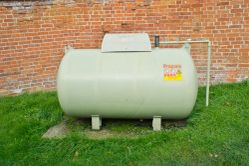Is It Better to Have an Aboveground or Underground Propane Tank?

Propane is an environmentally-friendly and energy-efficient fuel source. However, if you will be using it to power the majority of your appliances, you will need to have a tank on your property. Do you want it to be aboveground or belowground? The guide below weighs the pros and cons of both options.
Aboveground
Aboveground tanks are usually easier to install. They are also more accessible when they are in need of repairs or maintenance, which can reduce labor costs.
However, some people do not like the appearance of an exposed tank. Propane tanks must be placed at least ten feet from a house or building. However, they can be concealed by a strategically placed bush or other landscaping features.
 Propane gas can respond to changes in temperature.These tanks must always be painted a light color to reflect heat from the sun. The area around the tank must also be kept clear of debris.
Propane gas can respond to changes in temperature.These tanks must always be painted a light color to reflect heat from the sun. The area around the tank must also be kept clear of debris.
Underground
Underground tanks are more of an investment because of the installation costs. You’ll need to hire professionals to dig a hole and encase the tank in sand before being covered with dirt. The tank will then be buried, which can make it harder to diagnose and repair issues in the future. Tanks may also rise to the surface during a flood due to eroding soil.
However, homeowners with small yards or a lot of street exposure sometimes prefer them because they are nearly invisible, which helps with curb appeal. Grass can even be grown over the top. Tucked into the earth, they’re better able to withstand freezing temperatures and are more secure from other weather events and vandalism.
If you’re in need of propane gas in the Cincinnati area of Ohio or northern Kentucky, count on Auxier Gas, Inc. Based out of Batavia, OH, they have specialized in propane and fuel deliveries for 70 years. These professionals provide 24/7 assistance for residential and commercial clients. You can learn more about their company on their website or call (513) 724-7700 if you’re ready to place an order.
About the Business
Have a question? Ask the experts!
Send your question

